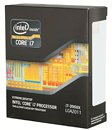Monday, December 12th 2011

Intel Core i7-3960X and i7-3930K CPUs Transitioning to C2 stepping in January
As previously reported, Intel's first wave of Sandy Bridge-E processors have VT-d (Intel Virtualization Technology for Directed I/O) disabled due to an errata in the C1 stepping. That issue couldn't be resolved in time for the launch but it's getting fixed with the C2 stepping which is set to start rolling out to customers on January 20th, 2012 (samples have already been delivered).
The CPUs moving to the C2 stepping are the hexa-core Core i7-3960X (3.3 GHz) and Core i7-3930K (3.2 GHz). Beside the fixed VT-d, the C2 chips will feature new S-spec and MM numbers so a BIOS update for current motherboards will likely be required.
The CPUs moving to the C2 stepping are the hexa-core Core i7-3960X (3.3 GHz) and Core i7-3930K (3.2 GHz). Beside the fixed VT-d, the C2 chips will feature new S-spec and MM numbers so a BIOS update for current motherboards will likely be required.

59 Comments on Intel Core i7-3960X and i7-3930K CPUs Transitioning to C2 stepping in January
This is cutting edge stuff. unless you live on the edge of high-end performance, and have those sort of performance needs, SKT 1155 is more than adequate. The only reason I'm using the 3960X it is becuase it was free. As soon as I can get a quad for this socket, I'm gonna. I'm not even overclocked right now, as the higher power consumption just isn't worth it, and CPU performance @ stock is enough for me, getting ~70FPS or more(usually 140 FPS or so in BF3 with 6950 Crossfire at stock, with stock shaders. With 1155, that dips below 60 quite often.
I mean, I kinda stopped really using an OC'ed system for gaming largely becuase of the realization that for what I want, memory bandwidth is more important. Plus, at stock, the difference between minimum framerates and maximums is much smaller, leading to a smoother gameplay expereince for me.If you have that, I see no need for you to upgrade at all.
Unfortunately, 1155 has little bus adjsutment, and on 2011, bus adjustments have no noticble impact on cache or memory performance, so even the extra available clocking isn't really all that useful, either. Core performance on 2011 doesn't affect memory bandwidth much, either, like it does on 1155, so even overclocking only has so much benefit on 2011, when it comes to gaming. I mean, of course it's faster when OC'd, but power consumption jumps so quickly, it's hard to justify
For me, I want three GPUs, to go with my three monitors for Eyefinity. Single monitor, 1155 is more than adequate.
Would TDP have been 150W or higher? I believe the SB-EP 8c part is 150W so it may have been higher.
And that is STOCK.
Xeons have more cores, but core frequency is much lower 2.1 - 2.6 GHz, I think? NOt 100% sure on that, TBH, like i said, no OC, means no use for me. NOt that I personally OC, but I need chips that will push boards properly so you guys can see what's what.
I don't really care who's faster, more expensive..that's up to you and your wallet. Every CPU has it's pros and cons.
Why do ya think those that already have chips are interested in revisions? ;) It's very clear that power consumption holds the SKT 2011 platform back a fair bit in 24/7 clocking. 4.3 GHz on air on all cores may be pushing it for a lot of chips. Most boards have 4.3 GHz for "Auto-clock"
Also Xeons are designed for highly parallel workloads that require an extremely reliable platform. Memory is CRC'ed using ECC so any errors that crop up in memory (which already is very uncommon in server platforms,) can usually get corrected, but for this, memory performance takes a hit. But since workloads are highly parallelized and you have 4 memory controllers per CPU (or two depending if it is a lesser or low-voltage model), you have a massive amount of raw power. It's a matter of being able to utilize the resources the server has, so ECC usually isn't an issue. It's what these chips were designed to do, but even in server environments, you will find that for a web server, a single request will most likely be single threaded if its a script in PHP or something like that, but it's the 50 people trying to run a script at the same time which is where the Xeon shines.
Edit: I'm also curious how Intel plans on getting around the quantum tunneling issue at sizes <= 16nm circuitry, but that's just a tangent.
Edit 2:Keep in mind that the CPU has many shared components, like the L3 cache, memory controller, and DMI so it doesn't quite scale like that. Also if this is really is based on a Xeon die, then a CPU with all 8 cores activated would be downclocked to match the 130-watt TDP. You won't see higher TDPs in servers.